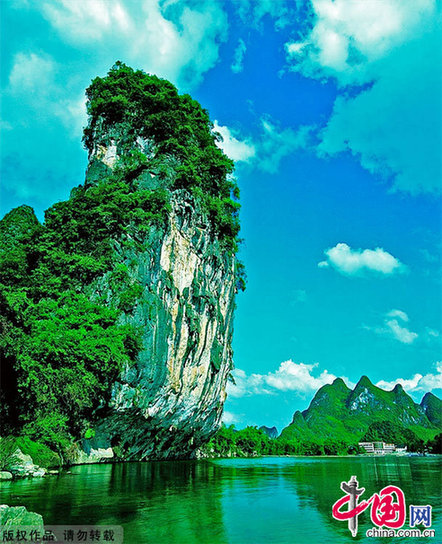Surrealistic scenery awes visitors to Yangshuo
 0 Comment(s)
0 Comment(s) Print
Print E-mail Shanghai Daily, March 14, 2017
E-mail Shanghai Daily, March 14, 2017
|
|
|
Photo/China.org.cn |
Tourist hotspots in China typically boast of stunning, panoramic scenery, but Yangshuo in the Guangxi Zhuang Autonomous Region of southern China takes the description of picture postcard perfection to a new level.
The area is famous for its almost dreamlike karst mountain scenery and rivers rippling through lush green fields. The panorama of this area has been described as “surreal, other-worldly and sublime.”
Once a sleepy backwater mostly visited by backpackers, Yangshuo has evolved into a major destination on tourist maps, bustling with modern hotels, bars and amenities. In the peak tourism season, visitors far outnumber locals.
Visitors from Shanghai usually fly to the city of Guilin and then board a bus for the 90-minute final leg to Yangshuo.
Once there, choices for accommodation are plentiful, ranging from luxury hotels to home-stay facilities.
After searching tourist guides online, my traveling companions and I chose a lodge in Fenglou Village, only 8 kilometers from downtown but still retaining a tranquil rural atmosphere. The village has only 500 permanent residents but is home to 10 hotels.
Most of the hotels are small, either renovated private homes or tourist cottages built to provide all modern facilities.
Fenglou is happily devoid of some of the more crass commercialism that now marks the famous 1,400-year-old West Street in Yangshuo, where small shops sell small wares and souvenirs. Most of the restaurants there offer pretty much the same menu.
Apsara Lodge, where we spent one night in January, is a three-story building that opened last year with 15 rooms. The tariffs range from 650 to 1,500 yuan (US$95.50-220.50) a night, which are more expensive than the prices at most other nearby hotels. But every room is commodious and well decorated with traditional furniture, and lodgers can enjoy stunning views of rivers and mountains from their balconies.
Even a rainy day could not dampen the enchanting environment. We made pots of tea and drank on the balcony, gazing at views that looked drawn from Chinese paintings. Low clouds draped the karst peaks.
In chilly weather, it was so cozy. In the lobby are books to read, provided from the lodge owner’s private collection. Tea made with ginger and jujube was on offer.
The hotel serves authentic local cuisine, such as rice noodles. It’s nice to stay in during rainy weather instead of having to go out and find meals.
Weather permitting, there are bikes for rent. The area is great for cycling amid the stunning scenery and fresh air. You don’t need to be a professional photographer to snap great pictures no matter where you aim your smartphone or camera.
Paved roads and bridges around the hotel are small but neat. Local women wash clothes in the area’s clean waterways.
This is an area rife with legends. One major attraction is Moon Hill, which has a 50-meter high semi-circular hole in it, the only remains of what was once a limestone cave.
It’s consider a must-see on tourist itineraries. You can climb 800 steps to the half-moon arch, accompanied by nettlesome hawkers peddling souvenirs and beverages.
The hill offers panoramic views of verdant countryside punctuated by knobby karst hills.
Legend has it that Moon Hill was the site of a palace where the Jade Rabbit and her companion Wu Gang lived. For many locals, the hill is still shrouded in mystery.
One farmer told us that former US president Richard Nixon planted a tree there when he visited Yangshuo in 1976.
There’s a saying that “the rivers and mountains in Guilin are the best in the world, and those in Yangshuo are the best in Guilin.”
Indeed, the Li River, which flows 83 kilometer from Guilin to Yangshuo, is as famous as the karst crags that flank it.
In January, the river cruise boats weren’t packed with tourists, giving those of us braving the weather some splendid views of the surrounding countryside from a different perspective. The water was so clear that we could almost see the bottom of the river.
Lucky visitors are able to catch scenes of locals fishing with cormorants.
There are an estimated 20,000 hills in the Yangshuo area. Some, like Yinzi Cliff and its stalactites, have been developed into tourism sites.
A park called Chinese Wonderland combines real hamlets with artificial landscape. Local residents, including members of ethnic minorities like the Zhuang, Dong and Miao, stage performances for visitors.
We were on a tight schedule and had only one day to devote to Yangshuo. But that was enough to convince us to return someday for a much longer stay.
How to get there: There are no direct flights between Shanghai and Yangshuo. You can fly to Guilin, which takes about three hours, and from there you have three options for the final leg of the trip:
? By bus — At the Guilin Bus Station on Zhongshan Road S., coaches to Yangshuo depart every 20 minutes. The 60-kilometer trip takes about 90 minutes and costs 27 yuan.
? By rail — A high-speed train to Yangshuo takes about 25 minutes and costs 20 yuan.
? By boat — Boat trips down the Li River are a popular way to reach Yangshuo from Guilin. The one-way cruise takes four to five hours, costs about 200 yuan and affords a leisure way to enjoy all the scenery along the way.






